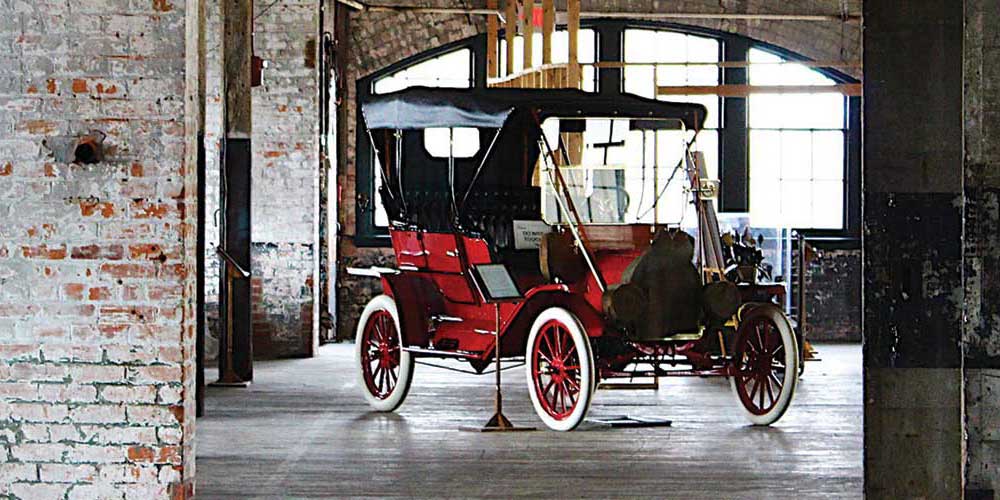By A. Wayne Ferens
Images the Wayne Ferens Collection
Published 3.29.2023
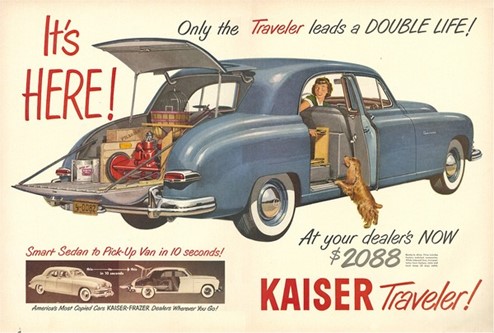 Sales brochure introducing the new Kaiser Traveler with a base price of $2,088. The Traveler/Vagabond generated 25 percent of Kaiser-Frazer sales in 1949.
Sales brochure introducing the new Kaiser Traveler with a base price of $2,088. The Traveler/Vagabond generated 25 percent of Kaiser-Frazer sales in 1949.
Established after World War II, the Kaiser-Frazer Corporation was the result of a partnership between automotive executive Joseph W. Frazer and industrialist Henry J. Kaiser. Kaiser-Frazer was the only new U.S. automaker to achieve some success surviving less than a decade. Always operating with limited cash and a limited range of products, most of their models introduced in the 1940s and early 1950s were strictly based on a single four-door sedan body.
There are several stories about the origins of the design of the Kaiser Traveler utility vehicle. One of them centered around H.J. Kaiser standing by a sedan and drawing the basic design in the dirt at the back of the car -- splitting the trunk lid and hinging it to allow the upper section to raise up and the lower section to fold down. This required finding a way to fold down the rear seat and modify the license plate so it can flip up or down under the lower lid. Another theory is that the Kaiser-Frazer engineers conceived it at the drawing board, most likely under chief body engineer Ralph Isbrandt, who spent his days and nights thinking of new ways to sell the conventional four-door sedan with fixed side window frames.
Isbrandt and his team came up several versions of the rigid sedan with a four-door "hardtop" version called the Virginian, the Kaiser and Frazer four-door "convertible," and a versatile delivery sedan called the Traveler/Vagabond. The Vagabond was an upgraded model in the Deluxe line.
Dealers were complaining to the Kaiser-Frazer sales department to come up with something new besides sedans. Since cost considerations were always a priority with any new model, proposals for fastbacks, station wagons, sports cars and limousines never made it past the drawing board. The Traveler/Vagabond would have to do. The 1949 model year was a disaster, with a $39 million operational loss.
Once the design concept was approved, the body engineers quickly began reconfiguring the back end by cutting the rear sheet metal from just above the rear window to just above the rear bumper pan. This deck section was then bisected horizontally at middeck hinging the two halves at the top and the bottom basically creating a two-piece hatch.
The rear seat was made to fold flat, and once the lower half of the back hatch was laid down, an eight-foot bed was provided, along with a spacious cargo compartment. Typically, the spare tire was bolted inside the trunk. In the Traveler, the spare was bolted inside the car to the left rear door. The door was welded shut at the factory and a fake door handle was installed.
A body development engineer named Harvey Anscheutz took on the challenge of designing an illuminated license plate holder that would comply with the laws of all 48 states. It flopped down when the lower half was opened and laid flat when the hatch was closed. Anscheutz spent three weeks on the design. A T-shaped handle was designed for the hatch and piano hinges were used on the lower part to provide support for additional weight. Wooden rub rails were used in the bed. Extra reinforcement was provided above the upper hatch to replace lost stiffness. The biggest problem was the sealing of the hatch. Customers complained of air and water leaks, wind noise and dust, and frustrated mechanics tried to repair them. In all, some 200 changes were made to the basic sedan, including relocating wiring harnesses and rear bumper guards, new openings for the rear window and suspension upgrades that included stiffer shocks and springs.
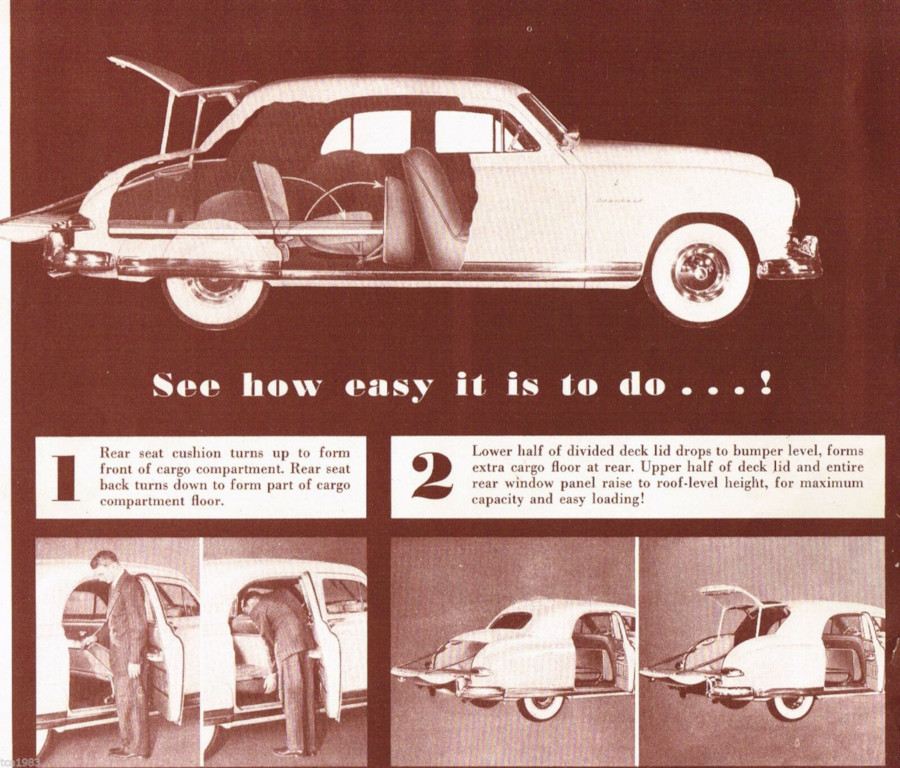 When the Traveler/Vagabond was introduced in 1948, advertising was typically done on radio, in popular magazines, newspapers and sales brochures. Literature and paper ads relied on artwork to illustrate the style and color of the cars. In this ad, a photo illustration was used to show the versatility and ease of conversion. It took only 10 seconds to complete two simple operations.
When the Traveler/Vagabond was introduced in 1948, advertising was typically done on radio, in popular magazines, newspapers and sales brochures. Literature and paper ads relied on artwork to illustrate the style and color of the cars. In this ad, a photo illustration was used to show the versatility and ease of conversion. It took only 10 seconds to complete two simple operations.
At $2,088 for the Traveler and $2,288 for the Vagabond, the vehicles were priced considerably less than the competition, with the only exceptions being the new Plymouth Suburban station wagon and the Nash Rambler wagon. The Vagabond was an upgraded Traveler that included a deluxe dashboard, fender skirts, and a pleated vinyl interior with the option of genuine leather.
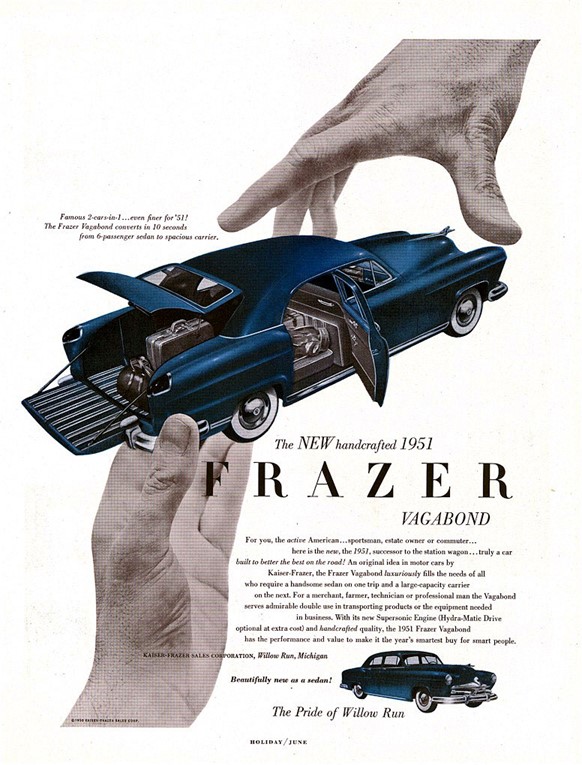 A 1951 Frazer Vagabond ad.
A 1951 Frazer Vagabond ad.
The company was in turmoil in 1949, selling just over 58,000 units. Unsold models were reserialed as 1950 models, and many of the unsold vehicles were Travelers and Vagabonds. There were also changes in company management and board members in addition to the financial losses.
In the spring of 1950, Kaiser introduced the restyled 1951 models conceived by Dutch Darrin working with Kaiser-Frazer stylists Herb Weissinger, Robert Robillard and Buzz Grisinger. The 1951s came in two and four doors, as did the Traveler, and were available in Special and Deluxe trims. The L-head 226 cu. in. six-cylinder engine had a small boost in horsepower to 115. The new models also had a five-inch shorter wheelbase at 118 inches and were some of the best designed cars of the early 1950s.
Kaiser built some 140,000 of the 1951 models, with just 3,500 Travelers produced. Most were the low-end Specials, with the rarest model being the two-door with only 1,000 sold. In 1952, the Traveler was available only on the lower-priced model, now called Deluxe, and again only a total of 1,000 were sold. Some special factory orders were built using the Traveler design on the upmarket Kaiser Manhattan. Only five were said to be produced with the upgraded Manhattan trim and upholstery.
In 1953 the Traveler was available only as a four-door with 1,000 Deluxe models and a few Manhattans sold. The Traveler was discontinued the following year.
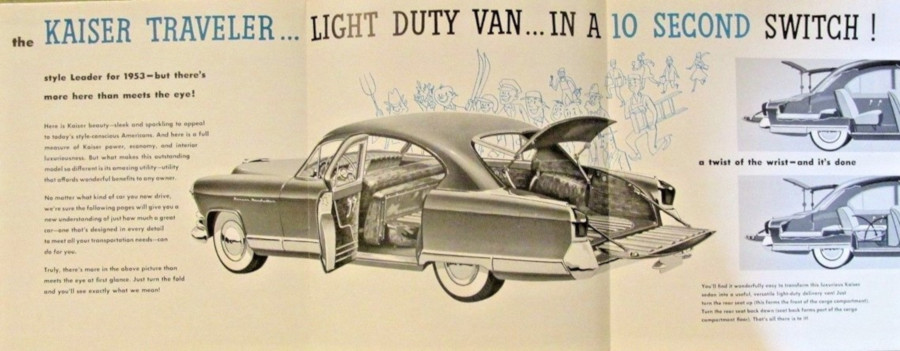 The last Kaiser Traveler came in four-door only as shown in this rare Kaiser sales brochure with photo illustrations that were the innovation of Kaiser-Frazer's advertising agency, Swaney, Drake and Bement.
The last Kaiser Traveler came in four-door only as shown in this rare Kaiser sales brochure with photo illustrations that were the innovation of Kaiser-Frazer's advertising agency, Swaney, Drake and Bement.
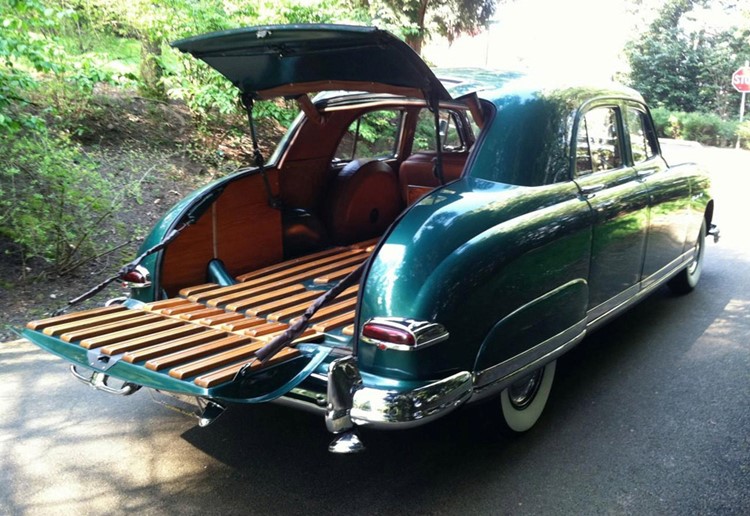 A more recent photo of a beautifully restored 1950 Kaiser Vagabond in Executive Green with the fully-opened split hatch showing the fold down rear seat, wooden rub rails, relocated bumper guards, T-handle, fender skirts, spare tire bolted to the left rear door and the hanging (with hatch down) license plate frame.
A more recent photo of a beautifully restored 1950 Kaiser Vagabond in Executive Green with the fully-opened split hatch showing the fold down rear seat, wooden rub rails, relocated bumper guards, T-handle, fender skirts, spare tire bolted to the left rear door and the hanging (with hatch down) license plate frame.
With the introduction of the 1954 Kaiser models, the company was basically on life support. Heavily in debt, short of cash and the competition now producing all steel station wagons with tons of cargo space and powered by more powerful engines, Kaiser signed a Letter of Intent with Industrias Kaiser Argentina (IKA) to move car production down there.
In 1955, the final year of car production in the United States, Kaiser built about 1,200 cars. The new source of income for the Kaisers was Willys Motors (formally Willys-Overland) that merged with Kaiser in 1953.
Bibliography:
Clark, R.M. “Kaiser-Frazer 1946-1955.” 1997.
Mueller, Jack. “Built To Better The Best: Kaiser-Frazer Corp.” 2005.
Holiday Magazine, June 1951
Ferens, A.W. “Kaiser-Frazer and Darrin.” 2018.


